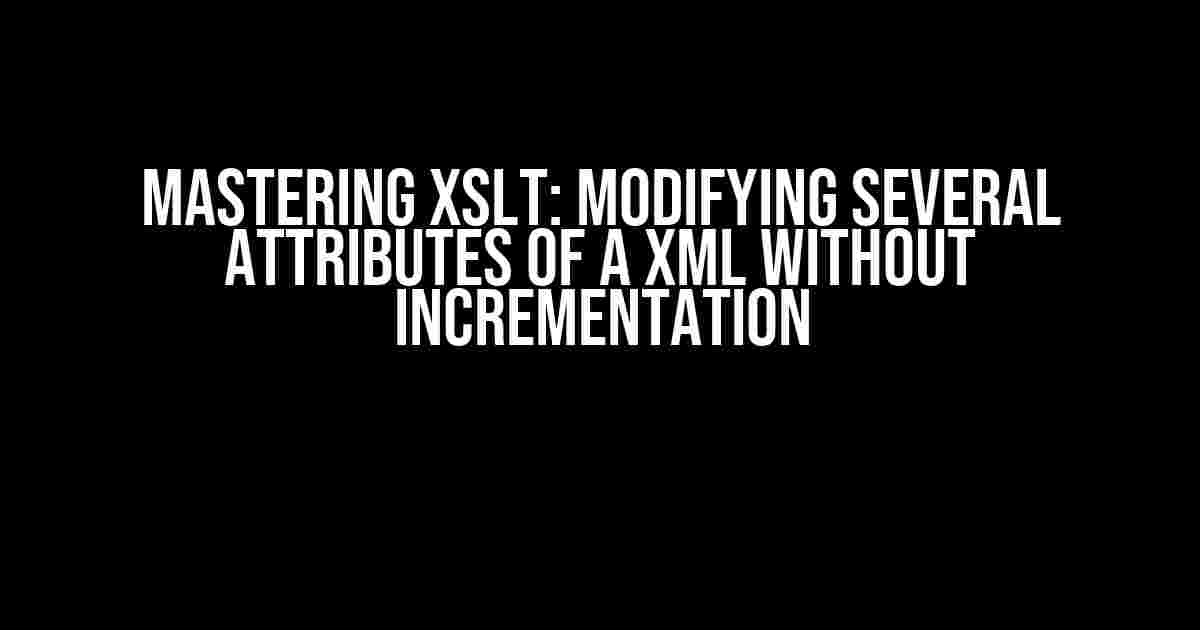Transforming XML documents using XSLT (Extensible Stylesheet Language Transformations) can be a daunting task, especially when dealing with multiple attributes. In this article, we’ll delve into the world of XSLT and explore how to modify several attributes of a XML document without incrementation. Buckle up, and let’s dive in!
Understanding the Problem
Imagine you have an XML document that contains multiple elements with various attributes. You need to modify these attributes using XSLT, but without incrementing their values. Sounds simple, right? Well, it’s not as straightforward as it seems. The challenge lies in selecting the correct XSLT elements and attributes to achieve the desired outcome.
The XML Document
<?xml version="1.0" encoding="UTF-8"?>
<catalog>
<book id="bk101">
<author>John Smith</author>
<title>XML for Beginners</title>
<genre>Computer</genre>
<price>39.95</price>
<publish_date>2000-10-01</publish_date>
<description>An in-depth look at creating applications with XML.</description>
</book>
<book id="bk102">
<author>Jane Doe</author>
<title>XSLT Mastery</title>
<genre>Computer</genre>
<price>49.95</price>
<publish_date>2001-02-01</publish_date>
<description>A comprehensive guide to mastering XSLT.</description>
</book>
</catalog>
XSLT to the Rescue!
We’ll use XSLT to modify the attributes of the XML document without incrementing their values. Our goal is to:
- Change the
genreattribute of allbookelements to “Programming” - Update the
priceattribute of allbookelements to “29.95” - Remove the
publish_dateattribute from allbookelements
The XSLT Stylesheet
<xsl:stylesheet xmlns:xsl="http://www.w3.org/1999/XSL/Transform"
xmlns:xs="http://www.w3.org/2001/XMLSchema"
exclude-result-prefixes="xs"
version="1.0">
<xsl:output method="xml" indent="yes"/>
<xsl:template match="book">
<book>
<xsl:attribute name="genre">Programming</xsl:attribute>
<xsl:attribute name="price">29.95</xsl:attribute>
<xsl:copy-of select="node()[not(self::publish_date)]"/>
</book>
</xsl:template>
</xsl:stylesheet>
Breaking Down the XSLT
Let’s dissect the XSLT stylesheet and understand how it achieves the desired outcome:
The xsl:template Element
The xsl:template element is used to define a template that matches the book elements in the XML document. The match attribute specifies the pattern to match, which in this case is the book element.
The xsl:attribute Element
The xsl:attribute element is used to create a new attribute or modify an existing one. In this case, we’re creating two new attributes:
genrewith a value of “Programming”pricewith a value of “29.95”
The xsl:copy-of Element
The xsl:copy-of element is used to copy all child nodes of the current node (in this case, the book element), except for the publish_date attribute. The select attribute specifies the nodes to copy, and the not(self::publish_date) predicate filters out the publish_date attribute.
The Resulting XML Document
After applying the XSLT stylesheet to the original XML document, we get:
<?xml version="1.0" encoding="UTF-8"?>
<catalog>
<book id="bk101" genre="Programming" price="29.95">
<author>John Smith</author>
<title>XML for Beginners</title>
<description>An in-depth look at creating applications with XML.</description>
</book>
<book id="bk102" genre="Programming" price="29.95">
<author>Jane Doe</author>
<title>XSLT Mastery</title>
<description>A comprehensive guide to mastering XSLT.</description>
</book>
</catalog>
Voilà! We’ve successfully modified the attributes of the XML document without incrementing their values using XSLT.
Common Pitfalls and Troubleshooting
When working with XSLT, it’s essential to be aware of common pitfalls and know how to troubleshoot issues. Here are a few common mistakes to watch out for:
- Failing to specify the correct namespace for the XSLT elements
- Incorrectly defining the template match pattern
- Not using the correct XSLT elements for attribute modification (e.g., using
xsl:elementinstead ofxsl:attribute)
Conclusion
In this article, we’ve explored how to modify several attributes of a XML document using XSLT without incrementation. By applying the techniques and best practices outlined above, you’ll be well on your way to becoming an XSLT master. Remember to always test your XSLT stylesheets thoroughly and troubleshoot any issues that arise. Happy transforming!
| Attribute | Original Value | Modified Value |
|---|---|---|
| genre | Computer | Programming |
| price | 39.95/49.95 | 29.95 |
| publish_date | 2000-10-01/2001-02-01 | Removed |
By following this guide, you’ll be able to modify several attributes of a XML document using XSLT without incrementation. Remember to practice and experiment with different XSLT elements and attributes to master the art of XML transformation.
- XSLT 1.0 Specification: Defining Template Rules
- XSLT 1.0 Specification: Creating Elements and Attributes
- XML.com: XSLT Tutorial
Frequently Asked Question
Get the scoop on modifying several attributes of a XML with a XSLT without incrementation!
Can I modify multiple attributes of an XML element using XSLT?
Yes, you can! XSLT allows you to modify multiple attributes of an XML element using the `
How do I avoid incrementation when modifying multiple attributes?
To avoid incrementation, you can use the `
Can I use a loop to modify multiple attributes?
While you can use a loop in XSLT, it’s not the most efficient way to modify multiple attributes. Instead, use multiple `
What if I need to modify attributes based on a condition?
No problem! You can use XSLT’s conditional statements, such as `
Can I use XSLT to modify attributes in a recursive XML structure?
Yes, XSLT can handle recursive XML structures! You can use the `

